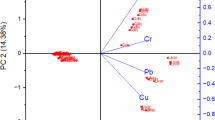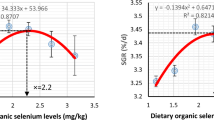Abstract
The decline of cadmium pollution in fish farms is needed by any adequate method. The present study was designed to explore the effect of dietary cadmium contamination and its amelioration by using dietary clay, probiotic (Bactocell®), vitamin C, and vitamin E supplementation in Nile tilapia fish diet on growth rate, feed efficiency, blood components, and cadmium residues. Fish were separated into 15 groups, each group of fish was stocked into three aquaria and each contains 20 fishes. The fish of the first five groups were fed the basal diet, the second five groups were fed the basal diet contaminated with 25 mg cadmium/kg, and the third five groups were fed the same diet contaminated with 50 mg cadmium/kg. Within each dietary cadmium level, the first group was fed the diet without any supplementation, the second was fed the diet supplemented with natural clay (bentonite) at level 3%, the third group was fed the diet supplemented with 1 g Bactocell®/kg, the fourth group was fed the diet supplemented 50 mg vitamin E/kg, and the fifth group was fed the diet supplemented with 100 mg vitamin C/kg. Live body weight, daily body weight gain, and feed intake of Nile tilapia decreased significantly (P < 0.001) with increasing dietary cadmium level, while feed conversion was impaired. Fish group fed on diets contaminated with 50 mg cadmium/kg recorded the lowest live body weight and weight gain. Serum total protein and albumin concentration significantly (P < 0.001) decreased, while serum creatinine, AST, and ALT significantly (P < 0.001) increased with increasing cadmium level in fish diets. Blood hemoglobin and total erythrocyte (RBCs) significantly (P < 0.001 or 0.05) decreased with cadmium contamination in fish diets, while leukocytes were insignificantly affected. Body cadmium residues increased significantly (P < 0.001) by increasing cadmium level in fish diets. Live body weight, daily body weight gain, and feed intake of Nile tilapia increased significantly (P < 0.001) with feed additive supplementation in diets, also while feed conversion improved. Fish group fed on diets supplemented with probiotic Bactocell® or natural clay recorded higher body weight and gain rate than the other experimental groups. Serum total protein, blood hemoglobin, and total erythrocyte increased, while urea-N, creatinine, ALT, AST, and leukocytes decreased as affected with the feed additive supplementation. Feed additive supplementation in fish diets significantly (P < 0.001) decreased cadmium residues in fish bodies. Irrespective of dietary cadmium level, feed additive supplementation in fish diet improved the growth rate and decreased the concentrations of serum creatinine and ALT. The obtained results indicated that feed additive supplementation could modify the function of the kidney and liver in fish exposed to the cadmium toxicity.
Similar content being viewed by others
References
Abdallah MAM, Morsy FAE (2013) Persistent organochlorine pollutants and metals residues in sediment and freshwater fish species cultured in a shallow lagoon, Egypt. Environ Technol 34:2389–2399
Afshar Mazandaran N and Rajab A (2001) Probiotics and their use in animal and poultry diets. Second edition, Noorbakhsh Tehran Publication, 392 pp
Anderson, DP (1990) Immunological indicators: effects of environmental stress on immune protection and disease outbreaks. In: American fisheries society symposium, 8:38–50
AOAC (1990) Association of official analytical chemists, official methods of analysis, 15th edn. Office of the Federal Register, Washington, D.C.
Ayyat MS, El-Marakby HI (2005) Studies on counteracting the dietary mercury toxicity in Nile tilapia (Oreochromis niloticus). Egypt J Nutr feeds 8(especial issue):1129–1144
Ayyat MS and Marai IFM (1997) Use of natural clays in animal production. Proceedings of the international conference on animal, poultry and rabbit production and health, Cairo, p 91 -111
Ayyat MS, Bakir AA, Attia AI, El–Zaiat AA (2005) The role of clay or vitamin E in silver montazah layer hens fed on diets contaminated by lead at various levels. 1- performance and egg components. Hungarian Anim Prod J 54(1):81–92
Berger A and Halver JE (1987) Effect of dietary protein, lipid and carbohydrate content on the growth, feed efficiency and carcass composition of striped bass, Morone saxatilis (Walbaum), fingerlings. Aquacult Res 18(4): 345–356
Beytut E, Yuce A, Kamiloglu NN, Aksakal M (2003) Role of dietary vitamin E in cadmium-induced oxidative damage in rabbit’s blood, liver and kidneys. Int J Vitam Nutr Res 73:351–355
Boyd CE (1990) Water quality in ponds for aquaculture. Bermingham Publishing Co., Bermingham
Boyd CE, Tucker CS (1998) Pond aquaculture water quality management. Kluwer, Norwell
Cinar M (2003) Cadmium and effects at biological system. Veterinarium 14:79–84
Cinar MA, Yigit A, Eraslan G (2010) Effects of vitamin C or vitamin E supplementation on cadmium induced oxidative stress and anaemia in broilers. Revue Med Vet 161:449–454
Dobrowolski R, Skowrońska M (2006) The study of trace metal levels in select environmental components of the Zemborzyce reservoir. Pol J of Environ Stud 4:537
Drevnick PE, Sandheinrich MB, Oris JT (2006) Increased ovarian follicular apoptosis in fathead minnows (Pimephales promelas) exposed to dietary methylmercury. Aquat Toxicol 79:49–54
Duncan DB (1955) Multiple range and multiple F tests. Biometrics 11:1–42
EL-Gazzar AM, Ashry KE, El-Sayed YS (2014) Physiological and oxidative stress biomarkers in the freshwater Nile tilapia, Oreochromis niloticus L., exposed to sublethal doses of cadmium. Alexandria J Vet Sci 40:29–43
Erdogan Z, Erdogan S, Celik S, Unlu V (2005) Effects of ascorbic acid on cadmium-induced oxidative stress and performance of broilers. Biol Trace Elem Res 104:19–31
Fuller R (1989) Probiotics in man and animals. J Appl Bacteriol 66:365–378
Gatesoupe FJ, Zambonino JL, Cahu C, Quazuguel P (1997) Early weaning of seabass larvae, Dicentrarchus labrax: the effect on microbiota, with particular attention to iron supply and exoenzymes. Aquaculture 158(1–2):117–127
Graig DS, Wayne C (1984) Simple automated wet digestion of animal tissues for determination of seven elements by atomic absorption spectroscopy. Tec Com 107:115
Hansen JA, Lipton J, Welsh PG, Morris J, Cacela D, Suedkamp MJ (2002a) Relationship between exposure duration, tissue residues, growth, and mortality in rainbow trout (Oncorhynchus mykiss) juveniles sub-chronically exposed to copper. Aquat Toxicol 58:175
Hansen JA, Welsh PG, Lipton J, Suedkamp MJ (2002b) The effects of long-term cadmium exposure on the growth and survival of juvenile bull trout (Salvelinus confluentus). Aquat Toxicol 58:165
Idriss AA, Ahmad AK (2015) Heavy metal concentrations in fishes from Juru River, estimation of the health risk. Bull Environ Contam Toxicol 94:204–208
Jain NC (1993) Essentials of veterinary hematology. Lea and Febiger, Philadelphia, USA
James R (2000) Effect of zeolite on reduction of cadmium level in water and improvement of haematological parameters in Oreochromis mossambicus. Indian J Fish 47(1):29–35
James R, Sampath K (1999) Effect of the ion-exchanging agent, zeolite, on reduction of cadmium toxicity: an experimental study on growth and elemental uptake in Heteropneustes fossilis (Bloch). J Aqua Trop 14(1):65–74
Jarup L, Akesson A (2009) Current status of cadmium as an environmental health problem. Toxicol Appl Pharmacol 238:201–208
Jiraungkoorskul W, Sahaphong S, Kosai P, Kim MH (2007) The effect of ascorbic acid on cadmium exposure in the gills of Puntius altus. Int J Zool Res 3:77–85
Jones FT, Ricke SC (2003) Observations on the history of the development of antimicrobials and their use in poultry feeds. Poult Sci 82(4):613–617
Kalay M, Canli M (2000) Elimination of essential (Cu, Zn) and non-nssential (Cd, Pb) metals from tissues of a freshwater fish tilapia zilli. Turk J Zool 24:429–436
Kaplan O, Yildirim NC, Yildirim N, Cimen M (2011) Toxic elements in animal products and environmental health. Asian Anim Vet Adv 6:228–232
Kaya S, Pirincci I, Tras B, Unsal A, Bilgili A, Akar F, Dogan A, Yarsan E (2002) In: Kaya S, Pirincci I, Bilgili A (eds) Metals, other inorganic vet radioactive agents. In: toxicology in veterinary medicine, 2nd edn. Medisan Press, Ankara, pp 207–250
Kim SG, Eom KH, Kim SS, ** HG, Kang JC (2006) Kinetics of Cd accumulation and elimination in tissues of juvenile rockfish (Sebastes schlegeli) exposed to dietary Cd. Mar Environ Res 62:327–340
Lafuente A, Gonzalez-Carracedo A, Romero A, Cabaleiro T, Esquifino AI (2005) Toxic effects of cadmium on the regulatory mechanism of dopamine and serotonin on prolactin secretion in adult male rats. Toxicol Lett 155:87–96
Layachi N, Kechrid Z (2012) Combined protective effect of vitamins C and E on cadmium induced oxidative liver injury in rats. Afr J Biotechnol 11(93):16013–16020
Mohanty BP, Mahananda MR, Pradhan S (2013) Cadmium induced toxicity and antioxidant activities in Labeo rohita (Hamilton). Environment and Ecology Research 1(2): 41–47
Ng TYT, Wood CM (2008) Trophic transfer and dietary toxicity of Cd from the oligochaete to the rainbow trout. Aquat Toxicol 87:47–59
Ognjanović BI, Pavlović SZ, Maletić SD, Zikić RV, Stajn AS, Radojicić RM, Saicić ZS, Petrović VM (2003) Protective influence of vitamin E on antioxidant defense system in the blood of rats treated with cadmium. Physiol Res 52:563–570
Okorie OE, Bae JY, Lee JH, Lee S, Park GH, Mohseni M, Bai SC (2014) Effects of different dietary cadmium levels on growth and tissue cadmium content in juvenile parrotfish, Oplegnathus fasciatus. Asian Australas J Anim Sci 27(1):62–68
Omar WA, Saleh YS, Marie MAS (2014) Integrating multiple fish biomarkers and risk assessment as indicators of metal pollution along the Red Sea coast of Hodeida, Yemen Republic. Ecotoxicol Environ Saf 110:221–231
Rastad AH, Samie A, Daneshvar F (2008) Effect of Bactocell and dry whey on performance and carcass characteristics of broiler chickens. J Sci Technol Agric Nat Resour 12(43):473–480
SAS Institute (2008) SAS stat user’s guide. version 9.2 edition. SAS Institute Inc, Cary, NC
Sen S, Chakraborty R, Sridhar C, Reddy YSR, De B (2010) Free radicals, antioxidants, diseases and phytomedicines: current status and future prospect. Int J Pharm Sci Rev Res 3(1):91–100
Sfakianakis DG, Renieri E, Kentouri M, Tsatsakis AM (2015) Effect of heavy metals on fish larvae deformities: a review. Enviro Res 137:246–255
Shalaby AA, Ayyat MS (1999) Effect of natural clay addition on the residues of profenofos and monocrotophos and their effects on some blood components in hens. Egypt J Appl Sci 14(6):286–300
Sharibi R, Pour F, Vahedasl A, Maniat M, Gavriloaie C (2015) Effects of probiotic Bactocell on growth and survival parameters of benni fish (Mesopotamichthys sharpeyi) fingerlings. Aquac, Aquar, Conserv Legis, Bioflux Soc 8(5):805–809
Sivakami R, Premkishore G, Chandran MR (1995) Sublethal effects of mercury on feeding energetics and body composition of the freshwater catfish Mystus vittatus (Bloch). J Aquac Trop 10(2):109–117
Swarup D, Patra RC (2005) Environmental pollution and its impact on domestic animals and wildlife. Indian J Anim Sci 75:231–240
Turner TT, Lysiak JJ (2008) Oxidative stress: a common factor in testicular dysfunction. J Androl 29:488–498
Virk P, Elobeid M, Hamad S, Korany Z, Al-Amin M, Daghestani M, Omer S, AlOlayan E, Siddiqui MI, Mirghani NM (2013) Ameliorative effects of Embilica officinalis and Rosmarinus officinalis on cadmium-induced oxidative stress in Wistar rats. J Med Plant Res 7(14):805–818
Wintrobe MM (1978) Clinical hematology. Henry Kimpton, p 448
Author information
Authors and Affiliations
Corresponding author
Additional information
Responsible editor: Philippe Garrigues
Rights and permissions
About this article
Cite this article
Ayyat, M.S., Mahmoud, H.K., El-Hais, A.EA.M. et al. The role of some feed additives in fish fed on diets contaminated with cadmium. Environ Sci Pollut Res 24, 23636–23645 (2017). https://doi.org/10.1007/s11356-017-9986-1
Received:
Accepted:
Published:
Issue Date:
DOI: https://doi.org/10.1007/s11356-017-9986-1




